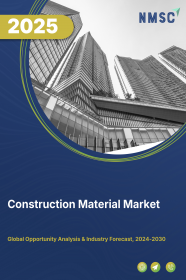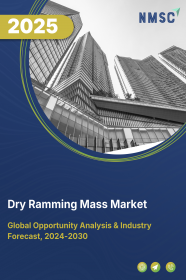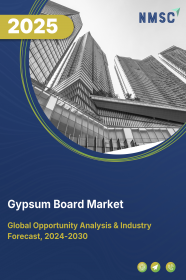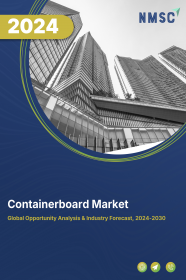
Construction Material Market by Material type (Aggregates & Fillers, Cementitious Products, Ceramics & Clay-Based Products, Metals, Glass & Glazing, Wood & Wood Products, Polymers, Plastics & Composites, Construction Chemicals & Coatings, Plaster & Gypsum Products, Insulation Materials (Thermal & Acoustic), Asphalt & Bitumen Products, Natural Stone & Dimension Stone, and Others), by Application and Others – Global Opportunity Analysis and Industry Forecast, 2024-2030
Industry Overview
The Construction Material Market size was valued at USD 1319.24 billion in 2023 and is predicted to reach USD 1862.88 billion by 2030 with a CAGR of 5.1% from 2024 to 2030. The market is the sector of the economy dedicated to the production, distribution, and sale of materials used in construction projects. These materials encompass a wide range of substances and products required for building, renovating, and maintaining structures, including residential, commercial, industrial, and infrastructure developments. The market is influenced by factors such as economic conditions, infrastructure investments, urbanization, environmental concerns, globalization, trade dynamics, industry trends and others.
Market Dynamics and Trends
The rising trend towards sustainable construction, exemplified by the growing prevalence of green buildings designed to mitigate environmental hazards, is driving the construction material market. For instance, the U.S. Green Building Council (USGBC) and the International WELL Building Institute (IWBI) collaborated in November 2022. This partnership aimed to expedite the uptake of health-conscious sustainable building practices, fostering fresh insights, streamlining processes, fostering innovation, and galvanizing a worldwide network of stakeholders.
Moreover, the rising number of smart cities across the world serve as a significant driver for the growth of the construction material market by fostering demand for innovative building materials and technologies tailored to the evolving needs of urban development. These initiatives prioritize sustainability, energy efficiency, and connectivity, creating a demand for eco-friendly construction materials, advanced technologies, and materials capable of accommodating smart infrastructure.
Moreover, the scale and complexity of smart city projects stimulate innovation in the construction material sector, leading to the development of new materials and construction techniques that enhance efficiency, durability, and sustainability. Consequently, smart city initiatives act as catalysts for market growth by fueling the adoption of cutting-edge construction materials and driving forward the evolution of urban landscapes worldwide.
However, the construction material market faces significant constraints due to fluctuations in key material costs such as steel, cement, and timber, as well as supply chain disruptions stemming from various factors. These factors can result in elevated project expenses and delays. Moreover, stringent regulatory standards regarding sustainability and safety add further limitations to material usage, creating challenges for market stakeholders to navigate.
On the contrary, introduction of 3D printing is poised to revolutionize the construction material market, presenting significant future opportunities. This technology allows for the fabrication of complex building components directly onsite or in a controlled environment, offering unparalleled design flexibility and customization. By utilizing materials such as concrete, polymers, and recycled plastics, 3D printing enables efficient construction processes with reduced material waste and labor costs.
Additionally, the ability to rapidly construct structures using 3D printing creates new possibilities for addressing housing shortages, disaster relief efforts, and sustainable construction practices. As 3D printing continues to advance and gain widespread acceptance, it is expected to drive innovation and growth in the construction material market, transforming the way buildings are designed and constructed in the upcoming years.
Market Segmentations and Scope of the Study
The construction material market is segmented on the basis of Material Type, Application, Distribution Channel, end user, and geography. On the basis of material type, the market is classified into Aggregates & Fillers, Cementitious Products, Ceramics & Clay-Based Products, Metals, Glass & Glazing, Wood & Wood Products, Polymers, Plastics & Composites, Construction Chemicals & Coatings, Plaster & Gypsum Products, Insulation Materials (Thermal & Acoustic), Asphalt & Bitumen Products, Natural Stone & Dimension Stone, and others. On the basis of Application, Structural Applications, Roofing, Flooring, Wall Systems, Utilities & Services, and Others. On the basis of Distribution Channel, the market is segmented into Specialty Retail Stores, Distributors and Wholesalers, Online Retail, Direct Sales, and Government Procurement. On the basis of End-User, the market is segmented into Residential, Commercial, Industrial, Infrastructure, and Institutional. Geographic breakdown and analysis of each of the aforesaid segments include regions North America, Europe, Asia-Pacific, and Row.
Geographical Analysis
The Asia Pacific region commands a significant portion of the market share, driven by swift industrialization and urbanization, alongside the pursuit of enhanced opportunities and living standards. The recent forecast by the United Nations, predicting a 50% surge in Asia's urban population by 2050, underscores a substantial opportunity for the construction material market in the region.
With an anticipated additional 1.2 billion urban residents, there will be an unprecedented demand for residential complexes, commercial spaces, and essential infrastructure. As governments and private entities grapple with the challenges of accommodating this population influx, the construction material market stands poised to play a crucial role in shaping the future urban landscapes of Asia. This not only fosters economic growth but also facilitates the development of smart, resilient cities capable of supporting the well-being of their residents.
Furthermore, the burgeoning government initiatives to propel the growth of smart cities are closely intertwined with the dynamics of the construction material market. As these initiatives drive demand for innovative and sustainable building solutions, they contribute to shaping the landscape of construction material procurement and usage.
For instance, the Indian government initiated the Smart Cities Mission, a program to address the challenges posed by India's rapid population growth and extensive urbanization in the years to come. Under this initiative, 100 smart cities have been identified for development by 2024, with the government of India and various states collaborating to enhance urban living and infrastructure.
On the other hand, North America is expected to show a steady rise in the construction material market due to rising government initiatives aimed at bolstering infrastructure development. These initiatives encompass various projects such as transportation, housing, and commercial developments, all of which require substantial quantities of construction materials.
For instance, in November 2023, The U.S. General Services Administration (GSA) invested $2 billion, directed to government building construction projects using low-embodied carbon (LEC) materials, including LEC asphalt, concrete, glass and steel.
According to the GSA, the U.S. General Services Administration (GSA) allocated $2 billion towards government building construction projects utilizing low-embodied carbon (LEC) materials. These materials include LEC asphalt, concrete, glass, and steel. The GSA's objective with this investment is to stimulate the market for American-made low carbon products, enhance U.S. manufacturing capabilities for next-generation goods and materials, and address the climate crisis while generating employment opportunities.
Also, in January 2022, government of the U.S. launched new program to repair and replace the bridges in U.S through funding from bipartisan infrastructure law. This law includes the largest investment in bridges since the creation of the Interstate Highway System. The initiative is expected to drive increased demand for materials such as concrete, steel, and others thus fostering innovation in the industry.
Competitive Landscape
Various market players operating in the construction material market includes ArcelorMittal, Buzzi SpA, Cemex S.A.B. de C.V., China BaoWu Steel Group Corporation Limited, China National Building Material Group Corporation, Cosentino Group, CRH plc, Etex Group, Heidelberg Materials, Holcim Ltd., James Hardie Industries plc, Kingspan Group, Knauf Group, Mapei SpA, Martin Marietta Materials, Saint-Gobain, Sika AG, UltraTech Cement, Vulcan Materials Company, Wienerberger AG.
These companies continue to adopt various market development strategies including product launches and partnerships to maintain their dominance in the semiconductor manufacturing equipment market. For instance, in January 2022, China National Building Material Company and Aramco launched NEXCEL, which is a new innovation center for the use of nonmetallic materials in the building and construction sector. This innovation center will offer superior lifecycle cost, efficiency and environmental advantages over their metal alternatives.
Also, in May 2022, HeidelbergCement one of the world's largest integrated manufacturers of building materials and solutions partnered with Giatec to continue revolutionizing the concrete industry with the help of sensor technology and AI. The sensor and AI helped concrete producers and construction companies in expanding digitalization and reducing the concrete carbon footprint.
Key Benefits
-
The report provides quantitative analysis and estimations of construction material market from 2024 to 2030, which assists in identifying the prevailing market opportunities.
-
The study comprises a deep dive analysis of the construction material market including the current and future trends to depict prevalent investment pockets in the market.
-
Information related to key drivers, restraints, and opportunities and their impact on the construction material market is provided in the report.
-
Competitive analysis of the players, along with their market share is provided in the report.
-
SWOT analysis and Porters Five Forces model is elaborated in the study.
-
Value chain analysis in the market study provides a clear picture of roles of stakeholders.
Key Market Segments
By Material Type
- Aggregates & Fillers
-
Cementitious Products
-
Ceramics & Clay-Based Products
-
Bricks & Blocks
-
Tiles (Ceramic/Porcelain)
-
Sanitaryware
-
-
Metals
-
Aluminium
-
Iron
-
Steel
-
Others
-
-
Glass & Glazing
-
Wood & Wood Products
-
Polymers, Plastics & Composites
-
Plastic Pipes/Fittings
-
Plastic Sheets, Films & Boards
-
Fiber-Reinforced Polymer Composites (FRP)
-
Other Polymer Products
-
-
Construction Chemicals & Coatings
-
Adhesives & Sealants
-
Concrete Admixtures
-
Waterproofing & Protective Coatings
-
Surface Treatments & Repair Compounds
-
Surface Primers & Bonding Agents
-
-
Plaster & Gypsum Products
-
Insulation Materials (Thermal & Acoustic)
-
Asphalt & Bitumen Products
-
Natural Stone & Dimension Stone
-
Others
By Application
-
Structural Applications
-
Roofing
-
Flooring
-
Wall Systems
-
Utilities & Services
-
Others
By Distribution Channel
-
Specialty Retail Stores
-
Distributors and Wholesalers
-
Online Retail
-
Direct Sales
-
Government Procurement
By End-User
-
Residential
-
Commercial
-
Industrial
-
Infrastructure
-
Institutional
By Region
-
North America
-
The U.S
-
Canada
-
Mexico
-
-
Europe
-
The U.K.
-
Germany
-
France
-
Italy
-
Spain
-
Denmark
-
Netherlands
-
Finland
-
Sweden
-
Norway
-
Russia
-
Rest of Europe
-
-
Asia-Pacific
-
China
-
Japan
-
India
-
South Korea
-
Australia
-
Indonesia
-
Singapore
-
Taiwan
-
Thailand
-
Rest of Asia-Pacific
-
-
Rest of the World (RoW)
-
Latin America
-
Middle East
-
Africa
-
Key Players
-
ArcelorMittal
-
Buzzi SpA
-
Cemex S.A.B. de C.V.
-
China BaoWu Steel Group Corporation Limited
-
China National Building Material Group Corporation
-
Cosentino Group
-
CRH plc
-
Etex Group
-
Heidelberg Materials
-
Holcim Ltd.
-
James Hardie Industries plc
-
Kingspan Group
-
Knauf Group
-
Mapei SpA
-
Martin Marietta Materials
-
Saint-Gobain
-
Sika AG
-
UltraTech Cement
-
Vulcan Materials Company
-
Wienerberger AG
REPORT SCOPE AND SEGMENTATION:
|
Parameters |
Details |
|
Market Size in 2023 |
USD 1319.24 Billion |
|
Revenue Forecast in 2030 |
USD 1862.88 Billion |
|
Growth Rate |
CAGR of 3.8% from 2024 to 2030 |
|
Analysis Period |
2023–2030 |
|
Base Year Considered |
2023 |
|
Forecast Period |
2024–2030 |
|
Market Size Estimation |
Billion (USD) |
|
Growth Factors |
|
|
Countries Covered |
20 |
|
Companies Profiled |
10 |
|
Market Share |
Available for 10 companies |
|
Customization Scope |
Free customization (equivalent up to 80 working hours of analysts) after purchase. Addition or alteration to country, regional, and segment scope. |
|
Pricing and Purchase Options |
Avail customized purchase options to meet your exact research needs. |




















 Speak to Our Analyst
Speak to Our Analyst





















